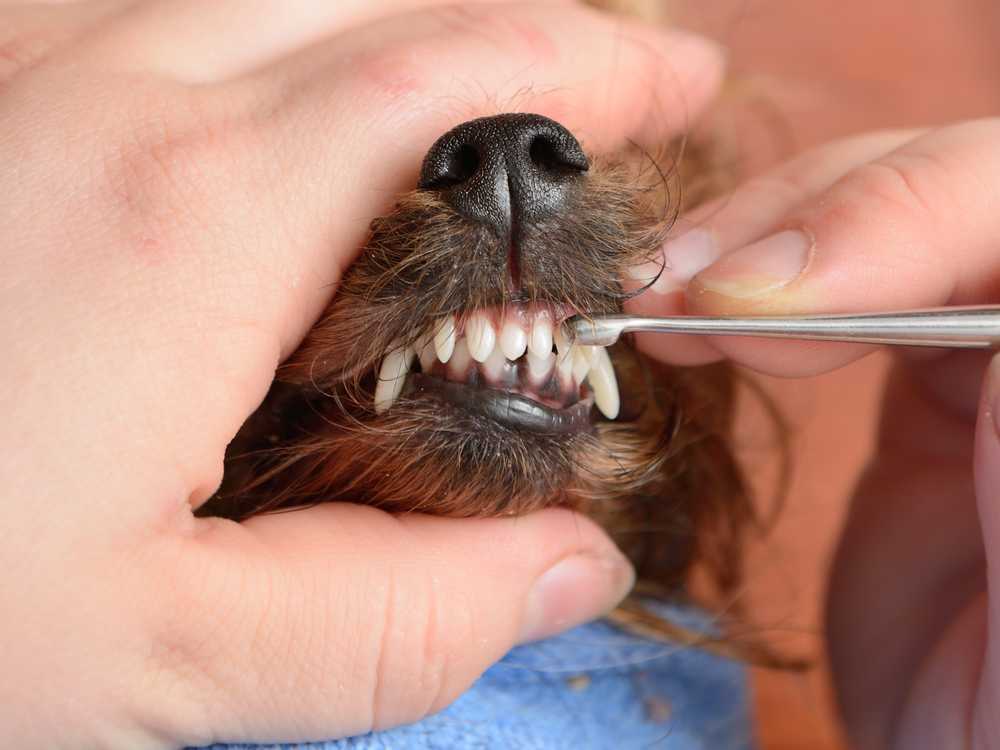Myths and misconceptions surround pet care, with a multitude of far-fetched ideas that anyone can post online. Some common myths related to pets’ health revolve around oral health and dental care, which are crucial to your pet’s overall health and well-being. Our Peak City Veterinary Hospital team banishes common pet dental health myths.
Myth #1: Pets have naturally clean mouths
Truth: The theory behind this myth is that a pet licks their wounds to promote healing. While this story has a tiny kernel of truth, pets’ mouths are full of bacteria. Some bacteria are good and help preserve a healthy oral environment, while other bacterial strains can cause serious health issues. Overgrowth of good bacterial strains can also cause harm.
Shortly after eating a meal, the oral bacteria in your pet’s mouth combine with food particles, saliva, and other debris to form a sticky film (i.e., plaque) on the teeth. This biofilm is the cause of oral health issues because of the irritating, inflammatory bacteria it contains, which has the potential to lead to significant, widespread infection. Unless you are constantly brushing your furry pal’s teeth, they’ll always have some bacteria and debris in their mouth.
Myth #2: Doggy breath is normal in pets
Truth: A mild breath odor is normal, especially if your pet just ate, but foul breath indicates an underlying dental problem. As oral bacteria, plaque, and tartar accumulate, they release noxious odors that can have you recoiling in disgust when your pet leans in to give you a kiss. Be on the lookout for less-than-fresh breath, as halitosis is often one of periodontal disease’s earliest signs.
Myth #3: Toothbrushing by the pet groomer is sufficient
Truth: Many groomers offer toothbrushing as part of their spa day session, but if your furry pal only visits the groomer a handful of times per year, those toothbrushing sessions are ineffective. Plaque begins sticking to teeth within hours after your pet eats a meal, and mineralizes into tartar within two to three days. Without regular toothbrushing—ideally daily—you cannot prevent plaque and tartar accumulation on your pet’s teeth. If you can’t brush your pet’s teeth daily, aim for at least two to three times per week to keep plaque and tartar at bay.
Myth #4: A dental chew a day will keep the veterinary dentist away
Truth: While an apple a day may keep the doctor away, your pet needs more than a daily dental chew to avoid needing care from a veterinary dentist. Without regular at-home and professional dental care, your four-legged friend may develop severe periodontal disease, necessitating a trip to an endodontic specialist. Prevent serious dental issues from occurring by not only giving your pet a daily dental chew, but also by regularly brushing their teeth, using food and water additives, scheduling routine veterinary dental exams, and staying on top of annual professional cleanings.
Myth #5: Hard treats and chews are best for pet dental health
Truth: The mechanical action that occurs while your pet chews on toys and treats helps scrub away plaque and some tartar, but items that are too hard can do more harm than good. Antlers, hooves, bones, and other rock-solid chews can cause enamel erosion, and tooth chips and fractures. Most commonly, the large upper premolar fractures and requires intensive oral surgery to remove the three-rooted tooth. To prevent dental emergencies, do not give your pet extremely hard treats, chews, or toys.
Myth #6: Pets don’t require dental cleanings until they are seniors
Truth: Older pets are more likely to experience dental issues after a lifetime of wear and tear on their teeth, but pets can experience dental disease from an early age. Up to 90% of all cats and dogs have some level of dental disease by age 3, and progressive conditions only worsen with age.
For example, kittens infected with feline leukemia virus (FeLV) from a young age can suffer from chronic gingivitis and stomatitis, predisposing them to resorptive disease development. A cat who has these lifelong conditions may need to have all their teeth extracted to relieve their pain.
Myth #7: Anesthesia-free dental cleanings are safest for pets

Truth: Many pet owners forgo regular professional dental care for their pets because they are worried about potential anesthetic risks. While any anesthetic or surgical procedure comes with some risk, the anesthesia’s benefits far outweigh the drawbacks, especially when anesthesia is calculated, administered, and monitored by highly trained and skilled professionals such as our Peak City Veterinary Hospital team members.
Keep in mind that an anesthesia-free dental cleaning can be performed by anyone. They need no training or licensing, and an anesthesia-free dental cleaning is purely cosmetic. During this procedure, your pet is restrained by a stranger as sharp dental instruments are used to scrape away plaque and tartar. Pain medication and sedatives are not administered, dental X-rays are not performed to check for hidden problems, and cleaning below the gumline, where 60% of the tooth structure lies, is not done. Additionally, if your pet has a diseased or damaged tooth that requires extraction, the procedure would not be performed, necessitating another dental cleaning performed under anesthesia by veterinary professionals.
Now that you know the truth about your pet’s dental care, you can promote their oral health and overall well-being. Schedule your furry pal’s oral exam and professional dental cleaning with our Peak City Veterinary Hospital team.









Leave A Comment